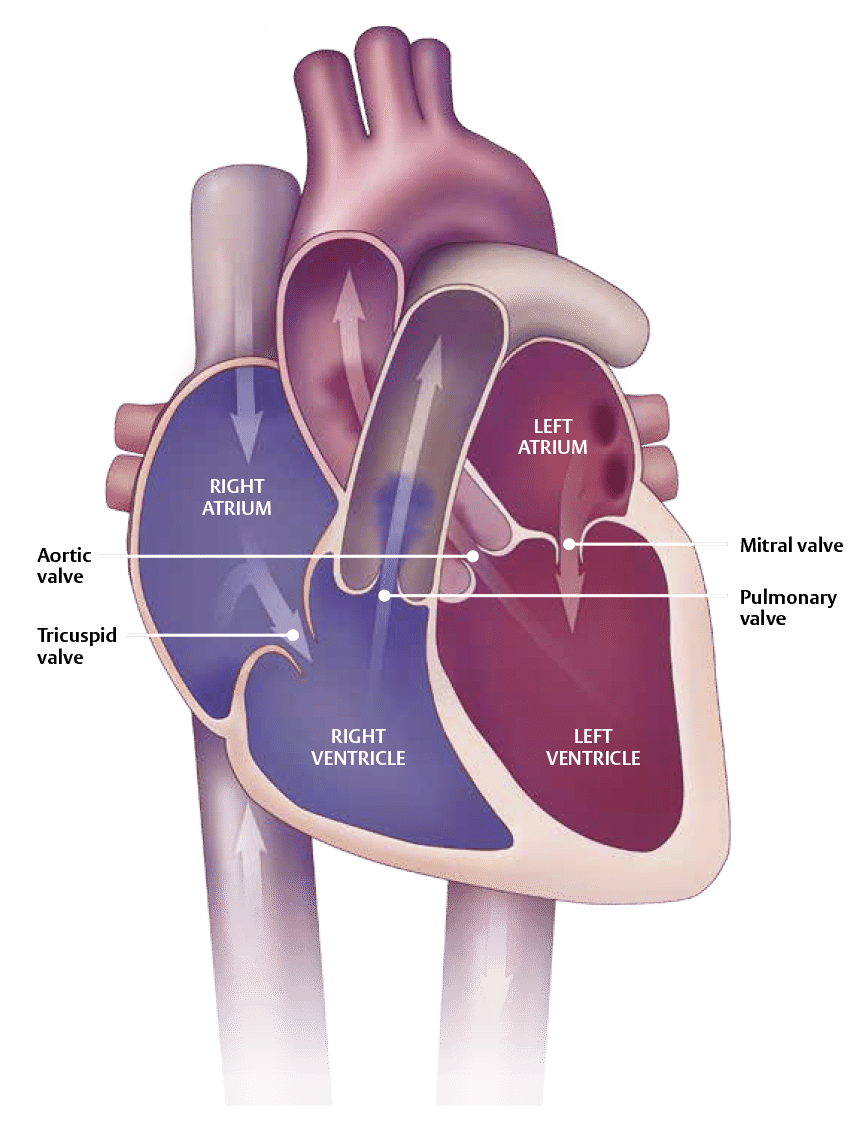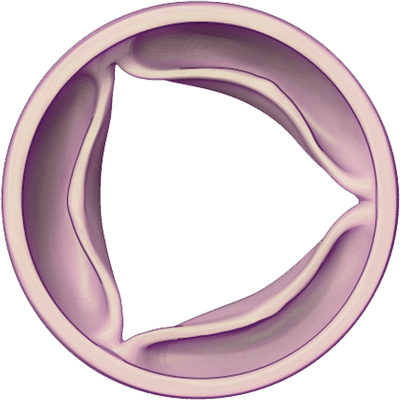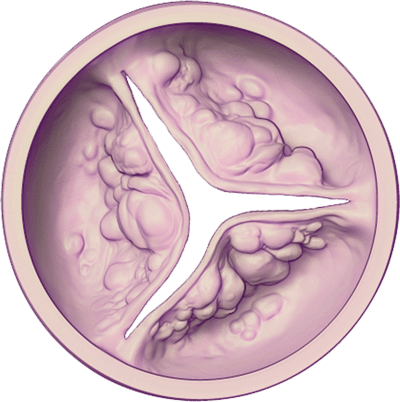Heart valve disease treatment in Tulsa
The structural heart program at the Oklahoma Heart Institute (OHI) is the first heart valve clinic of its kind in Tulsa. We are proud to offer exceptional surgical and non-surgical treatments delivered by a skilled team of cardiologists and board-certified providers committed to offering heart valve replacement and heart valve surgical and non-surgical transcatheter valve therapies. Our valve repair specialists use leading-edge technology to provide our patients with comprehensive cardiovascular treatments, clinical trials, and heart valve therapies that work. No matter what type of heart valve treatment you need, our care team will ensure you receive the compassionate, personalized care you deserve.

About our structural heart program
The structural heart program at the Oklahoma Heart Institute is Tulsa’s first heart valve clinic of its kind and remains the premier program with the highest level of superior outcomes in northeast Oklahoma. Our specialists are the most advanced and experienced in performing minimally invasive catheter-based procedures on the heart and heart valves. They have access to FDA-approved transcatheter valve therapies as well as cutting edge clinical trial treatments when applicable. Our multidisciplinary team of interventional cardiologists, cardiac surgeons and cardiovascular imaging specialists partner to develop individualized treatment plans for each patient. Together, they are committed to ensuring each patient receives compassionate and cutting edge care.
First in Tulsa or Oklahoma
| Transcatheter Aortic Valve Replacement (TAVR) | 5/2/2012 |
| Transapical TAVR | 11/13/2012 |
| Transaortic TAVR | 6/4/2013 |
| Valve-in-Valve TAVR | 11/26/2013 |
| TransCaval TAVR | 9/23/2014 |
| Mitral Transcatheter Edge-to-Edge Repair (MitraClip) | 11/18/2014 |
| Transcatheter Mitral Valve-in-Ring Replacement | 1/2/2018 |
| TAVR with TandemHeart | 10/12/2018 |
| Low Risk TAVR (PARTNER 3 UPR) | 11/20/2018 |
| BASILICA | 3/8/2019 |
| Transcatheter Mitral Valve Replacement (SUMMIT) | 6/16/2020 |
| Mitral Valve-in-MAC | 8/25/2020 |
| LAMPOON | 8/25/2020 |
| Transcatheter Tricuspid Valve Repair (CLASP II TR) | 12/1/2020 |
| Mitral Transcatheter Edge-to-Edge Repair (CLASP II MR PASCAL) | 4/6/2021 |
| Transcatheter Mitral Valve Replacement (ENCIRCLE SAPIEN M3) | 6/8/2021 |
| Transcatheter Tricuspid Valve Replacement (TRISCEND II EVOQUE) | 11/2/2021 |
| TAVR for Moderate Aortic Stenosis (PROGRESS Trial) | 2/15/2022 |
| TAVR with Edwards SAPIEN X4 (ALLIANCE Trial) | 7/12/2022 |
| 1000th TAVR | 9/27/2022 |
| AccuCinch Ventricular Restoration System Implant (CORCINCH-HF Trial) | 2/9/2023 |
| Whole Body Embolic Protection during TAVR with Emboliner Device (H2H Trial) | 6/13/2023 |
| APTURE Shunt Implant for Heart Failure (ALT-FLOW II Trial) | 5/2/2024 |
| First Commercial Evoque Transcatheter Tricuspid Valve Replacement | 5/21/2024 |
| TAVR with Abbott Navitor | 8/24/2024 |
| EMPOWER Trial randomization (Carillon Mitral Contour System) | 11/14/2024 |
| ENVISION Trial TAVR (Navitor valve for low/intermediate risk patients) | 1/14/2025 |
| Tricuspid Valve Transcatheter Edge-to-Edge Repair with Abbott TriClip | 1/28/2025 |
What is heart valve disease?
The heart is a muscular organ located in your chest between your lungs, and it is designed to pump blood through your body. The right side of your heart pumps blood through the lungs, where the blood picks up oxygen. The left side of the heart receives this blood and pumps it into the rest of your body. Each time your heart beats it pumps blood through valves by contracting its chambers. These valves open in one direction allowing blood to flow forward. In between beats, the heart’s chambers quickly relax, and its valves close, preventing blood from flowing backward.
There are four valves in the heart:
- Aortic valve: Controls blood flow from the left ventricle to the aorta, sending blood to the rest of the body
- Mitral valve: Controls blood flow from the left atrium and left ventricle
- Pulmonary valve: Controls blood flow from the right ventricle to the pulmonary artery, sending blood to the lungs to pick up oxygen
- Tricuspid valve: Controls blood flow from the right atrium to the right ventricle
Heart valve disease occurs if one or more of your heart valves don’t work well. Birth defects, age-related changes, infections, or other conditions can cause one or more of your heart valves to not open fully or to let blood leak back into the heart chambers.

Heart valve conditions
Our structural heart program provides treatment for two common types of heart valve conditions: aortic valve stenosis and mitral valve regurgitation.
Aortic valve stenosis is when your heart valves narrow and do not completely open, disrupting the blood flow in the heart and forcing it to work harder to pump blood. Stenosis often occurs due to a build-up of calcium on the aortic valve’s leaflets (flaps of tissues that open and close).
Symptoms generally occur when the narrowing becomes more severe, although some patients do not experience any symptoms for years. The most common symptoms of aortic valve stenosis include:
- An irregular heartbeat
- Chest pain
- Coughing up blood
- Increased fatigue, especially during activity
- Lightheadedness or feeling dizzy
- Shortness of breath
- Swollen feet or legs
When left untreated, the heart’s muscles will weaken, increasing the patient’s risk of heart failure and death. Severe aortic stenosis is a very serious problem. Half of the people who feel sick from this problem die within an average of two years, making treatment imperative for patients diagnosed with this condition.
Mitral valve regurgitation is a heart valve condition in which your mitral heart valve doesn’t fully close, causing blood to leak backwards through the valve. If leakage is severe enough, blood cannot move through the rest of the heart and body.
Symptoms of mitral regurgitation include:
- An irregular heartbeat
- Heart murmurs
- Shortness of breath
- Rapid, fluttering pounding heartbeat (palpitations)
- Swollen feet or ankles
Treatment of mitral regurgitation depends on how severe your condition is, whether it is getting worse and whether you have symptoms. Untreated severe mitral regurgitation can cause heart failure or heart rhythm problems.
Tricuspid valve regurgitation is a medical condition where the tricuspid valve, located between the right atrium and right ventricle of the heart, does not close properly. This results in blood flowing backward into the right atrium during the contraction of the right ventricle, instead of moving efficiently forward.
Symptoms of tricuspid valve regurgitation include:
- Fatigue
- Irregular heart rhythms
- Swelling in the abdomen or legs
Causes of tricuspid valve regurgitation range from congenital defects to conditions like pulmonary hypertension or infections. Proper diagnosis and treatment are essential for managing the condition effectively.
Structural heart disease therapies
We provide the following structural heart therapies:
- Atrial septal defect and patent foramen ovale closure – This non-surgical procedure addresses the patent foramen ovale and atrial septal defects. During this procedure, the physician inserts a catheter into the site of the defect. Once in place, the catheter delivers a collapsed mesh closure device inside, which expands and blocks the hole. The catheter is then removed.
- Left atrial appendage (LAA) closure – The LAA is a small pouch on the left side of the heart. Patients with atrial fibrillation (abnormal heart rhythm) have a risk of blood clots forming in the LAA. During LAA closure, a small catheter is used to deliver a closure device to the left side of the house. The device expands like an umbrella to seal off the entrance to the pouch, and then the catheter is removed.
- Pulmonary vein and artery stenting – This minimally-invasive procedure is used to open up a pulmonary blood vessel that may have narrowed for a variety of reasons. A stent (small mesh tube) is placed over a tiny deflated balloon and delivered to the narrowed portion of the vessel using a catheter. Once in place, the balloon is inflated, expanding the stent and anchoring it in. The balloon and catheter are then removed.
- Alcohol septal ablation – This non-surgical procedure treats hypertrophic obstructive cardiomyopathy (HOCM) by inserting a small, deflated balloon into the heart through a catheter. Alcohol is then injected through the tube into the area where the heart muscles are abnormally thick, causing the heart muscle cells to shrink and die.

Healthy Aortic
Valve – Closed

Healthy Aortic
Valve – Open

Diseased Aortic
Valve – Closed

Healthy Aortic
Valve – Open
Treatments for heart valve disorders
Our multidisciplinary team of interventional cardiologists, cardiovascular surgeons and heart imaging specialists offer various services to treat heart valve disease, including:
- Transcatheter aortic valve replacement (TAVR) – During TAVR, providers work together to replace the aortic valve using catheters. This minimally-invasive technique allows a new aortic valve to be inserted within the diseased aortic valve without your doctors needing to perform traditional open-heart surgery. This treatment option is great for patients with severe aortic stenosis. Learn more about TAVR.
- Transcatheter mitral valve repair — This minimally invasive procedure uses a catheter to repair the mitral valve in the heart without the need for open-heart surgery. Transcatheter mitral valve repair is commonly used to treat mitral regurgitation, a condition where the valve does not close properly, causing blood to flow backward into the heart. Transcatheter mitral valve repair can significantly improve symptoms such as shortness of breath and fatigue, enhancing the patient’s quality of life.
- Transcatheter mitral valve replacement — During this procedure, the provider replaces the mitral valve with an artificial valve. This treatment can be utilized in patients who have previously had mitral valve surgery, or in patients who have mitral valve regurgitation or stenosis.
- Tricuspid valve repair – This minimally invasive procedure uses a catheter to repair the tricuspid valve in the heart without the need for open-heart surgery. This is commonly used to treat a damaged tricuspid valve and tricuspid regurgitation, which changes the direction of blood flow.
- Tricuspid valve replacement – During this procedure, the provider replaces the tricuspid valve with an artificial valve. This treatment can be utilized in patients who need to repair tricuspid regurgitation or a previous tricuspid valve surgery.
- Balloon valvuloplasty – During this procedure, a catheter with a small, deflated balloon attached to the tip is guided into the damaged valve. The balloon is then inflated to stretch open the valve opening, allowing more blood to pass through. The balloon is then deflated and guided back out of the body. This is a minimally-invasive treatment option for patients with degenerative valve disease.
Our cardiovascular doctors are committed to delivering the best possible outcomes for your particular condition. No matter what type of treatment you need, our team will work together to ensure you receive the exceptional heart care you deserve.
TAVR
Transcatheter aortic valve replacement (TAVR) is a minimally invasive treatment option for patients with severe aortic stenosis (narrowing of the aortic valve). TAVR is a state-of-the-art alternative to open heart surgery and has been shown to be highly effective. During TAVR, interventional cardiologists and cardiothoracic surgeons work together to replace the aortic valve with catheters through a small puncture in the skin, most frequently in the groin. This technique allows a new aortic valve to be inserted within the diseased aortic valve without opening the chest as a traditional open heart surgery. This minimally invasive approach allows patients to recover more quickly, reduces the risk of surgical complications, allows patients to go home sooner than traditional surgery and allows the patient to return to a baseline more rapidly.

Transfemoral TAVR Procedure (TF-TAVR)
- Minimally invasive method to replace diseased aortic valve
- Performed through the femoral artery in leg
- Treatment for high-risk with severe symptomatic aortic stenosis
TAVR benefits and recovery
Aortic valve replacement is the most effective treatment to alleviate symptoms and improve survival in patients with severe/critical aortic stenosis. The incidence of aortic stenosis multiplies with age and as the life span of our population increases and as patients age, a large number will require aortic valve replacement. Since outcomes with medical management are uniformly poor, TAVR is a less invasive alternative for patients with aortic stenosis who need aortic valve replacement. Additional benefits include shorter recovery time, minimally invasive, significantly less pain than with open heart surgery and it’s a life-saving option for patients with severe aortic stenosis.
